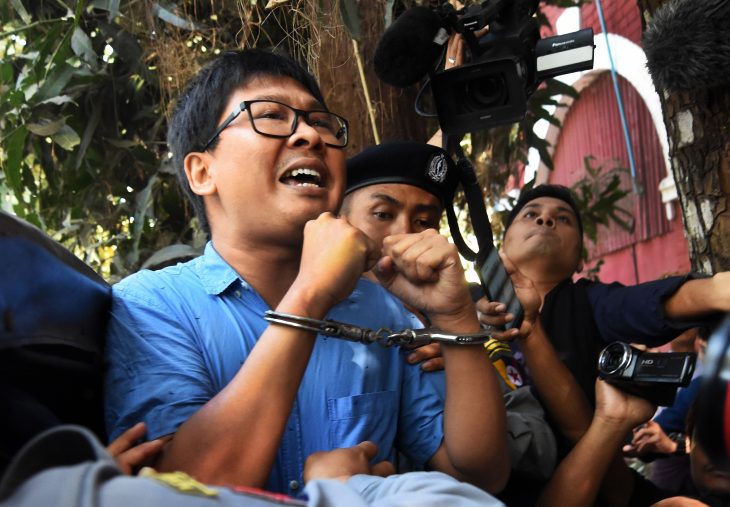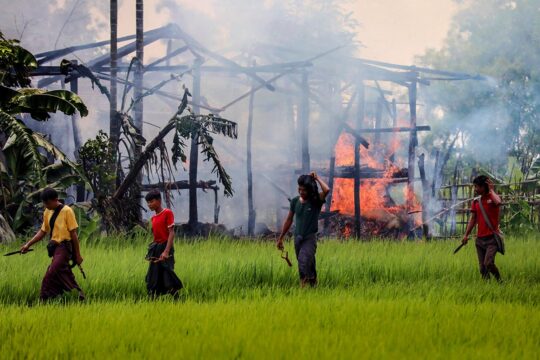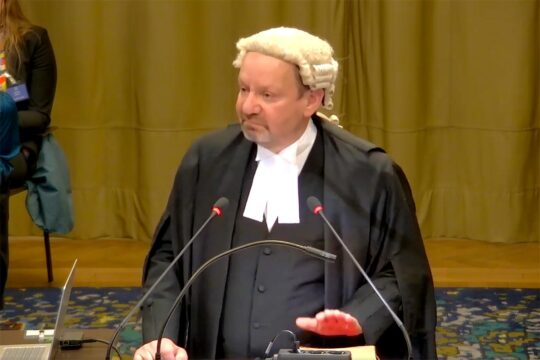Across Southeast Asia – but especially Myanmar, Cambodia and the Philippines – journalists are facing arrest, intimidation and violence.
On the afternoon of December 12 in Myanmar, Ma Pan Ei Mon asked her husband, Reuters journalist Ko Wa Lone, if she should cook dinner for him and his colleague, Ko Kyaw Soe Oo.
“Kyaw Soe Oo was in Yangon from Sittwe,” Pan Ei Mon told Frontier. “But [Wa Lone] told me that they were meeting the police for dinner.”
Later that night, Wa Lone and Kyaw Soe Oo were arrested near a restaurant on the northern outskirts of Yangon. Prior to their arrest, the journalists had been investigating the killing of 10 Rohingya men at Inn Din village, in Rakhine State’s Maungdaw Township, in late August. They had uncovered evidence and testimony tying the killings to security forces and Rakhine villagers.
Wa Lone and Kyaw Soe Oo remain on trial. They are accused of breaching the country’s Official Secrets Act, which carries a maximum penalty of 14 years’ imprisonment.
The circumstances around their arrest have been a key point of contention during the trial, which at times has descended into farce.
Myanmar’s Ministry of Information said that the pair were “arrested for possessing important and secret government documents related to Rakhine State and security forces”, which they intended to share “with foreign media”.
Arresting officers said the documents were found during a routine patrol, but the pair told relatives that they were arrested almost immediately after being handed documents by two policemen they had met at the restaurant for the first time. They said they had not read the documents before they were arrested.
Two police officers were also arrested under the Official Secrets Act, but it is unclear whether they are still being held or if they have been charged.
The trial has revealed the glaring gaps in Myanmar’s judicial system. Under heavy scrutiny from the defence lawyer – a rare occurrence in the country’s courts – one of the arresting officers said he had burned his notes, without offering an explanation why.
Another prosecution witness was shown to have “Thet Oo Maung” – Wa Lone’s real name – and “No.3 road and Nilar road junction” – the place where police said they were arrested – written on his hand, apparently to ensure his testimony matched the official version of events.
The trial has attracted widespread international condemnation; those who have joined the chorus calling for the pair’s release include former US President Bill Clinton and UN Secretary-General Mr Antonio Guterres. Last week, the London-based firm of world-renowned human rights lawyer Ms Amal Clooney, said she would serve as their counsel.
“The trial has been farcical in many respects and has laid bare that the two Reuters reporters’ arrest was a government setup from the start to suppress their news coverage of the Rohingya crisis,” Mr Shawn Crispin, Southeast Asia representative, Committee to Project Journalists, told Frontier.
“If authorities are willing to take down Reuters on spurious charges, then what local media will dare to report on sensitive stories, particularly the Rohingya humanitarian crisis? The case, filed under the vague and overbroad Official Secrets Act, will inevitably lead to widespread self-censorship among journalists going forward.”
For many, the prosecution of the journalists highlights the huge backsliding on press freedom in Myanmar over the past year. Yet this phenomenon is not confined to Myanmar; it stretches right across Southeast Asia, from the arrests of journalists covering the Rakhine crisis to restrictions on media access to Indonesia’s West Papua in the east.
While the issues in West Papua for example are not new, developments in Myanmar, as well as Cambodia, the Philippines and Malaysia, are relatively recent, and represent a worrying trend towards illiberalism and, in some cases, authoritarianism.
The night of the arrests
On the evening of December 12, Pan Ei Mon said she tried to call her husband shortly after 9pm, but his phone was switched off.
“He is usually home by about 9pm,” she said. “Sometimes his phone is off, but he knows I was home alone so he uses someone else’s phone to contact me.”
When he was still not home by 10pm, Pan Ei Mon said she phoned the Reuters driver who had taken the journalists to the restaurant. He said the meeting had not yet finished.
“At 10.45 I called again. The driver told me the interview was still happening, but there was something different in his voice,” she said. “I think he didn’t want me to worry, so he told me the meeting was still happening.”
After midnight she said she received a phone call from the Reuters office in Yangon, telling her that her husband and Kyaw Soe Oo were missing.
Pan Ei Mon said she spent a frantic night desperately trying to contact Wa Lone and Kyaw Soe Oo, but to no avail.
“I thought I was going crazy. My anxiety was limitless,” said Pan Ei Mon, fighting back tears. “I was even worried if they were still alive. I mean, what does ‘missing’ mean?”
After two weeks of being held incommunicado, Wa Lone and Kyaw Soe Oo were finally brought to court on December 27.
“Since I have seen him at court, I feel better,” she said. “But every time I go to the court, I hope I can bring him home with me. I feel discouraged and weak without him.”

Journalists from the Cambodia Daily working in Phnom Penh shortly before the publication closed in September. (AFP)
The Reuters case is not the first time journalists in Myanmar have been detained in the past year.
In June 2017, three reporters – two from DVB and one from The Irrawaddy – were arrested after covering a drug-burning ceremony in territory controlled by the Ta’ang National Liberation Army, an armed group active in northern Shan State.
The trio were released in September, after spending two months in Hsipaw Prison facing a charge under Article 17(1) of the Unlawful Associations Act.
Then, in October, three journalists and their driver were arrested in Nay Pyi Taw after flying a drone near the parliament building. They also spent two months in jail, under the 1934 Aircraft Act, before being released in December – just days after the Reuters journalists were arrested.
“Just as one of your colleagues is released, it feels like another one goes inside. It’s like a revolving door,” one Yangon-based journalist told Frontier at the time.
Reporters operating in the country face personal risks, too. In December, Ko Kyaw Lynn, a freelance journalist based in Rakhine State, was stabbed while walking through downtown Sittwe.
Kyaw Lynn told Frontier that on December 20 he was stabbed in the back with a makeshift weapon. He was rushed to hospital, where he underwent surgery, before being released four days later.
“I do not feel safe. I do not feel secure anymore,” said Kyaw Lynn, who is now in hiding in Yangon and still too weak to return to work.
Kyaw Lynn said he believed the attack was related to the articles he had been writing concerning corruption and illicit drugs in his home state, and that his attackers had been paid to kill him.
“In our Rakhine State, there are people who force-feed hatred among the communities,” he said. However, he added that young people are determined to stand up against those “who show nothing but hatred and aggression to any and all international organisations, exploit the ignorance and lack of awareness of the grassroots people, traffic narcotics and lie to the people”.
“If we stand up and resist them by criticising them, we are labelled as human rights defenders or activists greedy for US dollars and traitors, and we are blamed and verbally abused.”
‘As bad as it has ever been’
Which Southeast Asian country has backslid the furthest on press freedom over the past year? It would be a close race, but Cambodia must surely be near the front.
“Cambodia’s façade of media freedom collapsed in 2017,” said the Cambodian Center for Independent Media in its most recent survey on press freedom.
One of the most notable developments was the closure of The Cambodia Daily in September, after a battle with the government over a US$6 million-dollar tax bill. The Daily, which was founded in 1993, had been critical of Prime Minister Hun Sen’s increasingly authoritarian administration. With an election expected later this year, critics view the tax demands as being politically motivated.
The paper went down swinging; in its final edition, published on September 4, its front page ran with the headline “Descent into Outright Dictatorship” above a story about the arrest of Mr Kem Sokha, leader of the Cambodian National Rescue Party.
The CNRP was dissolved a month later, a move that Mr Charles Santiago, chairman of ASEAN Parliamentarians for Human Rights, called “the final nail in the coffin for Cambodian democracy”.
The paper’s closure followed the shuttering of more than a dozen radio stations, including Voice of America, Radio Free Asia and Voice of Democracy.
“The situation is as bad as it’s ever been,” said a Cambodia-based journalist who spoke to Frontier on condition of anonymity because of safety concerns in the country. “The absence of [the Cambodia Daily] means that people have less independent and in-depth stories.
“The situation will get worse in the next few months ahead of the election, I think. There will be a lot more pressure on journalists,” said the journalist.
In November, two former reporters for RFA, Mr Uon Chhin and Mr Yeang Sotherain, were arrested under charges of espionage, and the pair remain in jail.
Last month, reports emerged that The Phnom Penh Post was the next publication to be targeted by the Hun Sen regime with a hefty tax bill, this time totaling $3.9 million.
However, the paper’s CEO Mr Marcus Holmes denied the tax demand was politically motivated and said talks were continuing with the country’s General Department of Taxation.
“This is a perfectly routine tax audit. This is not us being shut down,” Holmes told Southeast Asia Globe. “We’re not in the same situation the Cambodia Daily was. This is a number that is halfway through an ongoing negotiation with the tax office about a tax audit that happened at the end of last year.”
Whatever the outcome of the tax bill, it is clear that press freedom in Cambodia has taken a giant leap backwards in the past year.
“The situation for journalists in Cambodia has deteriorated rapidly, closing what was once a relatively open space for the media in the region,” said Crispin from the CPJ.
“Prime Minister Hun Sen has made it clear that his government will no longer tolerate media criticism and is moving with a vengeance against previously critical newspapers and broadcast outlets,” he said, adding that Hun Sen appeared to taking cues from “his financial patron China on how to repress and control the media”.
Battling the president
Governments are also targeting independent media elsewhere in the region, not least in the Philippines where President Rodrigo Duterte has Rappler in his sights.
Rappler was only founded in 2012 but has been one of the strongest critics of the bombastic leader, particularly his controversial war on drugs that has seen thousands killed. The International Criminal Court recently announced a “preliminary examination” into the campaign, to which Duterte has threatened to withdraw from the ICC.
In January, he accused Rappler of being a “fake news outlet” – repeating the well-worn trope of US President Donald Trump towards any media outlet that is critical of his administration.

CEO of Philippine news website Rappler, Maria Ressa (centre), arrives at the National Bureau of Investigation (NBI) headquarters in Manila. (AFP)
Later that month, Rappler’s licence was revoked and the publication’s political correspondents have been barred from covering government events, including those outside the presidential palace. The government denied that the decision to revoke Rappler’s licence was an attack on a free press.
“We would like to deny that the state has infringed on the freedom of the press, particularly on Rappler or any of its reporters,” said palace spokesman Harry Roque in a statement. “If the President wanted to do that, he could have just sent the armed forces and padlocked them as done by other regimes. The President has never done that.”
Frontier was unable to reach Rappler founder Ms Maria Ressa for this article, but she told The Guardian in March that her publication is ready to fight the charges against them.
“The end goal is to keep reporting as long as we’re a democracy, and this, as far as I know, is still a democracy. And in a funny way it’s a backhanded compliment that the president sees us, a small start-up, as a threat,” said Ressa.
“I’m banking on the fact that there are still good people in government who will prevent this,” Ressa told the British publication. “I’ve been a journalist for more than 33 years, and at Rappler we refuse to change, I refuse to be bullied.”
Rappler was not the first Philippines outlet to be targeted by Duterte. In March 2017, he criticised newspaper Philippine Daily Inquirer and television station ABS-CBN for what he called unfair coverage of his presidency, and said they would meet their “karma” one day.
Months later, renowned Filipino businessman Mr Ramon Ang – who helped finance Duterte’s presidential campaign – acquired control of the Inquirer. Duterte also threatened to block ABS-CBN’s application to renew its operating licence, which requires congressional approval.
A worrying trend
While it is Myanmar, the Philippines and Cambodia in particular that have attracted the most attention for their attacks on press freedom, few other countries are making progress.
In the 2017 Press Freedom Index, published by Reporters without Borders, the only country in Southeast Asia to break into the top 100 globally was East Timor.

Even Indonesia, which is the top-ranking member of the Association of Southeast Asian Nations, has seen some setbacks.
“Indonesia’s media is, for the most part, quite vibrant,” said Dr Ross Tapsell, a researcher from the Australian National University, who specialises on media in Southeast Asia. “Professional journalists can report on a number of issues that they couldn’t 20-odd years ago – with the exception of [West] Papua.”
However, Tapsell said that the government is increasing its crackdown on criticism on social media, including the use of the Electronic Information and Transaction Law, which is being used to arrest citizens for online defamation.
“It has been around since 2008, but it is increasingly being used by powerful people, such as politicians, to arrest those who criticise people in power,” Tapsell told Frontier.
In recent days, press freedom in Malaysia – where an election is due to take place later this year – has also been thrust into the limelight, with the country’s cabinet on March 21 approving a draft law against “fake news”. The bill was being discussed in parliament as Frontier went to print.
Under the Anti-Fake News 2018 Law, anyone deemed to have published fake news faces a fine of up to 500,000 ringgit (K171 million), up to 10 years’ imprisonment, or both.
The bill defines fake news as “news, information, data or reports which is or are wholly or partly false”, according to a Reuters report.
“The drafting of the bill is intended to provide for several offences related to the circulation of fake news and measures to curb fake news,” said Ms Azalina Othman Said, a minister in the Prime Minister’s Department. “The bill was drafted for public interest to protect citizens from the wave of fake news and from becoming victims of fake news,” she said, adding that the new law would not curb free speech.
But critics disagree.
Mr Phil Robertson, Asia director for Human Rights Watch, said that Najib and his administration was “taking a page out of Donald Trump’s playbook”.
“The issue is the government doesn’t like independent journalists doing critical reporting on Malaysia’s myriad scandals and rights abuses, and has been looking for a way to attack popular news sites,” he told Frontier. “The ‘fake news’ laws are best understood as the next assault on media freedom in the region.”
Malaysian Prime Minister Najib Razak is planning to introduce an anti “fake news” law. (AFP)
Some shining lights
Bright spots in Southeast Asia’s media landscape are difficult to find, but they do exist. Close to home, Frontier’s senior reporter Ko Mratt Kyaw Thu was in February awarded the Kate Webb Prize for Asian Journalists, the first Myanmar recipient of the prestigious award.
Mratt Kyaw Thu has been covering conflict in Rakhine State – including being chased out of Maungdaw by a mob threatening to kill him in September – as well as the civil war in the country’s north.
In his acceptance speech, Mratt Kyaw Thu dedicated the award to the journalists who have been arrested in the country in the past year – including the Reuters pair, who themselves were granted the PEN/Barbey Freedom to Write Award in February. Last month, Ko Swe Win, editor of Myanmar Now, was one of three people awarded the EU’s Schuman Award for Human Rights.
Despite the challenging environment, new outlets have been established in the region. One example is Mekong Review, a quarterly literary journal that publishes fiction, essays, reviews and poetry from across Southeast Asia. An independent publication with no political, institutional or commercial affiliations, it exists only on the proceeds of sales and subscriptions from readers.
Mr Minh Bui Jones, the Review’s chief editor, said he founded the publication as a personal project to stay connected to Southeast Asia after living in Cambodia for seven years.
“We created the magazine in a month, which sounds improbable, I know, but it was made easier by the fact that the idea of a regional literary journal has been bubbling in my head for several years,” Jones told Frontier by email.
He said that, as the magazine does not run news or political commentaries, it didn’t have many issues with the increasing restrictions in the region. “In addition, we’re small, obscure and have bugger-all influence,” he said.
Additionally, he warned against over-generalising too much about Southeast Asia, drawing parallels in press freedom between countries such as Myanmar, Cambodia and Vietnam. “We need to be careful when we generalise. Southeast Asia is not Western Europe,” he said.
With regards to the future of the magazine, Jones said that he doesn’t really have future plans. “Everything is in the present. We live issue by issue. We’re like those streetfood vendors. Our future rests with our content.”
Dark days
Crispin, from CPJ, said that the press freedom situation is deteriorating across all of Southeast Asia.
“These are dark days to be a journalist almost everywhere in Southeast Asia,” he said.
No one is feeling that more keenly than Wa Lone and Kyaw Soe Oo, who appeared in court once more on March 21, exactly 100 days since they were arrested. Pan Ei Mon was there again, hoping in vain for the release of her husband.
“Ever since we first met, I have always looked up to him,” she told Frontier on February 15, a day after she had attended another of the pair’s hearings, which fell on Valentine’s Day.
“When I see him at court, I try not to show my inner feelings to him; I try to hide my sadness,” she said. “But this pretending is exhausting.”
This article was first published on Frontier Myanmar.






